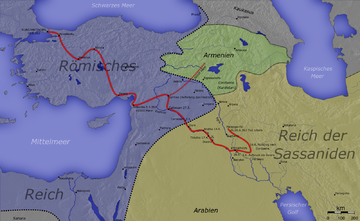Battle of Samarra
| Battle of Samarra | |||||||
|---|---|---|---|---|---|---|---|
| Part of the Julian's Persian War | |||||||
 A map of the campaign up to the battle of Samarra |
|||||||
|
|||||||
| Belligerents | |||||||
| Sasanian Empire | Eastern Roman Empire | ||||||
| Commanders and leaders | |||||||
|
Shapur II Ardashir II |
Julian the Apostate (DOW) | ||||||
| Strength | |||||||
| Unknown; a force comparable to the Roman army | 35,000 | ||||||
| Casualties and losses | |||||||
| Unknown | Unknown | ||||||
The Battle of Samarra took place in June 363, after the invasion of Sassanid Persia by the Roman Emperor Julian. A major skirmish, the fighting was indecisive but Julian was mortally wounded in the battle. The Romans, stranded deep in Persian territory and suffering from a lack of supplies, were forced to accept terms for peace.
Julian invaded Sassanian Empire with a force of 65,000 men, hoping to win a major victory against Persians in the east and replace Shah Shapur II with his brother Ormisdas. Julian made two blundering mistakes at the very onset of the invasion. He split his force into two, one under General Procopius numbering 30,000 men, which went to northern Mesopotamia, and one numbering 35,000 men under his own leadership. His second mistake was not defeating the main Sassanid army before attacking the capital, which would eventually lead to expedition's failure in 363. Julian at first won a tactical victory outside Ctesiphon, but could not take the city. Even worse, Procopius failed to join him with his army, for unknown reasons.
David S. Potter suggests that Julian's main faults was that he made a very risky campaign and that he didn't bring adequate siege train. Therefore, he had to retreat after realizing that Ctesiphon was too strongly defended to be taken by assault while his army was running out of supplies. However, the Sassanid army, under Shapur, implemented a scorched earth policy while harassing Romans all their way back to Roman Mesopotamia. Julian, realizing that his army could not be resupplied or reinforced, tried to force a set piece battle with his enemy, but could not.
So decision was taken to retreat through the district of Corduene to the north, where there was hope to find adequate supplies. After a few days of advancing through the enemy country, despite defeating Persian skirmishes and inflicting them heavy losses in the Battle of Maranga, the demoralized army was essentially depleted of provisions and tired of the continuous fighting.
...
Wikipedia
